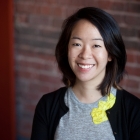James Wong is a man of routine. Every morning, the 63-year-old resident of San Francisco’s Sunset District meets his friends for some tai-chi exercise. Then they decide where to eat lunch. It’s usually at one of three senior centers in the southwest corner of the city. There they can get a hot meal, perhaps even freshly cooked, for $2.
Recently Wong and his crew have added a new element to their routine: dinner at S & E Café or Prince Cooking, two Hong Kong–style cafes in the Outer Sunset. These restaurants that are part of an innovative new program that allows seniors to choose from a special menu of healthy Chinese American favorites and dine with friends and family whenever they want.
“We go there, have a good time, gossip a little bit,” he said. His favorite menu item is fish with curry sauce over pasta. “It’s a good value for us, considering you usually pay $10 to $12 for a dish. Now it’s $3.50 for a dish, a drink, and a little dessert.” He’s a fan, and he knows what a well-run dining program should look like: he previously worked as a restaurant manager at a Mariott hotel in San Mateo.
The program, called CHAMPSS (Choosing Healthy Appetizing Meal Plan Solutions for Seniors), is a step towards giving seniors more flexibility and choice beyond the two usual ways to get low-cost meals: congregate meals at senior centers or home-delivered meals. Both are limited in terms of menu variety (there’s usually only one meal option per day) and meal-time (diners must eat at set times for congregate meals, usually limited to an hour or 90 minutes). Plus, some seniors just don’t find the idea of a congregate meal at a senior center that appealing.
“A lot of seniors now, especially the baby boomers, they don’t want to tell people they’re attending a senior center program,” said Josephine Ma, director of fund development at Self-Help for the Elderly, the San Francisco senior service agency that runs the program. With CHAMPSS, “they can just go to a restaurant any time they want and enjoy gathering and having fun with friends. That opens up the social life of the seniors. They love it. They can go whenever they want, and pick whatever they want from the menu.”
Outer Sunset resident David Lok eating lunch off the CHAMPSS Menu at Prince Cooking.
At S & E Café, a Hong Kong-style diner on 19th Avenue near Taraval Street, diners can order from the 16-item CHAMPSS menu four days a week, anytime during the café’s hours, 10:30 a.m. to 2 a.m. Another perk is that the CHAMPSS menu is heavy on Chinese American fare, ideal for the Sunset’s large Chinese American population; about half of the district’s residents are Asian American, and 99 percent of the CHAMPSS diners are as well. There’s wonton noodle soup, BBQ pork fried rice, fish fillet with bok choi over rice, braised tofu with bok choi and mushroom over rice, and the Hong Kong–style perennial favorite comfort food, baked rice dishes. The meals come with milk or calcium- and vitamin D–fortified orange juice, and fruit or Jello for dessert—all for a bargain suggested donation of $3.50, tax and tip included. (A second CHAMPSS dining establishment, Prince Cooking on Noriega Street near 21st Avenue, was added in June. The menu has a similar Asian and American bent: salmon pasta with Japanese gravy and seafood udon with vegetables, for example.)
The CHAMPSS program is only the newest approach in a longstanding effort dating back to the 1970s, that aims for culturally appropriate, low-cost meals for an exponentially growing and increasingly diverse senior population. And the call to address this population is only getting stronger. The number of people age 65 and older is expected to double over the next 30 years. Today two in 10 elders are elders of color; by 2050 that number will double to over four in 10. Over the next four decades, AAPI elders will have the largest relative population growth among all elders. And diverse elders experience disproportionately higher poverty rates, according to a 2012 report by the Diverse Elders Coalition: nearly 10 percent of AAPI elders have incomes below the Federal Poverty Thresholds, compared to 9 percent of all American elders and 7 percent of non-Hispanic white elders.
San Francisco in particular has seen an explosion of growth among Asian American seniors. Asian Pacific Islanders made up 27 percent of the city’s senior population in 1990; that jumped to 40 percent by 2008. During that time, the number of white seniors decreased by over 9,000, while Asian Pacific Islanders increased by almost 25,000. Today more than 60,000 API seniors live in San Francisco, and a third of those live below 150 percent of the Federal Poverty Line.
Groups catering to this booming AAPI elder population today with culturally sensitive meals must navigate not only cuts in funding but also strict regulations on food preparation and nutrients. Yet ambitious and innovative new programs like CHAMPSS are attempting to serve this population—literally—with not only healthy, nutritious meals from their heritage but also with increased choice and flexibility about how and when they eat their meals.
---
The issue of culturally appropriate meals has been enduring challenge.
“It’s been an issue ever since communities of color and Jewish communities have complained about how the meal program doesn’t meet their needs,” said Donna L. Yee, CEO of the Asian Cultural Center in Sacramento. “There’s been an ongoing roil about how to make the program be more responsive to the seniors it serves.”
Although a number of groups in California and New York have been serving culturally appropriate meals for the past 30 years, Wesley Lum, president and CEO of the National Asian Pacific Center on Aging, says that progress on the issue is uneven throughout the states. “To be frank, to have just tasty nutritional meals for seniors, that seniors want to eat, is a challenge, let alone something that is culturally or ethnically specific,” Lum said.
Yet Lum notes that he’s seen a push towards meals that can be tasty and nutritional. “Meals can be done creatively so that they’re diverse and people have choice. So it’s not just something that’s served, and it’s not just mush.”
The CHAMPSS program in San Francisco is run by Self-Help for the Elderly, a nearly 50-year old group that serves some 60 to 100 Chinese meals a day (suggested donation: $2.50) at each of 11 senior centers spread throughout the Bay Area. It’s one of a number of providers that the city’s Department of Aging and Adult Services has contracted with to serve solely cuisine targeting different ethnic populations, among them Centro Latino de San Francisco (serving Mexican and Central American meals), Kimochi in Japantown, and Russian American Community Services.
“We take a lot of effort to make sure people have meals that are culturally appropriate because we know that nutrition is really important,” Anne Hinton, executive director of San Francisco’s Department of Aging and Adult Services. “We know people in their 70s, 80s, and early 90s, who are used to eating certain types of food, are more likely to eat a meal they’re familiar with. As you get older, senses can dim. Taste buds can be not as sharp as when you’re younger. So familiar food will attract them to eat the food more than something less well known.” And the food is good, Hinton notes. “We get a lot of praise for all of our ethnic foods. Some people even travel all over the city to because they think the food is so good.”
Hinton had been on the lookout for novel ways to operate programs in areas of the city where affordable properties for senior services are scarce but the need is great, like the Sunset District. “We only have one senior center in that area, run by Self-Help, and it already has two meal seatings,” Hinton noted. “The site cannot accommodate any more meal servings. We knew they would want to expand if they could, they just didn’t have the site. That just seemed like a great opportunity to do something different.” Then she heard about Kansas.
The first-ever CHAMPSS meal was served in 2008 at a Hy-Vee grocery store food court in Johnson County, Kansas, which contains many of Kansas City's affluent suburbs. Like the Self-Help for the Elderly, Johnson County had watched the number of seniors at their congregate meal sites decline in recent years, despite a growing number of older adults. In fact, on a national basis, both congregate and home-delivered nutrition programs have been experiencing declines since 2010, for a variety of reasons. Johnson County managed to correctly pinpoint the source of its decline to limited dining hours and menu choices. The CHAMPSS in Kansas became a success, and the people behind the program gave presentations around the country to show how it could be done.
To Hinton, the Kansas program was a revelation. “They were using businesses to deliver programs,” she marveled. “Find a business that has a kitchen and make use of it in a neighborhood where you’re having trouble finding a kitchen yourself.” She was confident it would be perfect for the Sunset. “We didn’t have any reservations that people would go to the site. We were pretty clear that if we could establish a site like this, we would have more than enough customers.”
The hardest and most time-consuming part was finding a restaurant to partner with, according to Kelly Chew, Self-Help for the Elderly’s director of nutrition and senior centers, who visited about 60 eating establishments in the Sunset and the adjacent Richmond District over the better part of 2013 before signing on with S & E Café, already well-known among the Chinese American community. Chew and Ma both admit that the café sees very little profit, and may even operate at a loss, in the CHAMPSS partnership—the actual cost for each meal is around $10, Self-Help gives the café $7, and the rest is covered through Self-Help’s fundraising efforts and funds from the city’s Department of Aging and Adult Services. They highly praised S & E Café’s owner for his generosity and support of seniors and the community.
Following a kitchen remodel and meetings with Self-Help’s dietician to develop a menu, the first CHAMPSS meal was served in July 2014. Within a month, they had dished up 2,000 more meals. Today the restaurant sees around 50 CHAMPSS customers a day on average, and on some days up to 90 such customers, far exceeding expectations of 40 customers per day. The number of active CHAMPSS clients has ballooned from 200 in the first few months to about a thousand today.
Most are Chinese: “It’s been really well-received by seniors in the Chinese community,” Ma said proudly. Chew underscores that fact by saying that the vast majority pay the full $3.50 suggested donation—a testament to how much they appreciate the program. “They love the CHAMPSS program, that’s why they are willing to support it,” she said.
Prince Cooking is one of two San Francisco restaurants that are part of an innovative new program that allows seniors to choose from a special menu of healthy Chinese American favorites and dine with friends and family whenever they want.
What’s more, seniors are clamoring for even more CHAMPSS restaurants, Chew says. Self-Help is continuing to seek out restaurants, perhaps at a sit-down–style restaurant instead of a café, and maybe at a place serving Asian fusion food. After all, eating one kind of cuisine all the time can get tiresome, even if it’s your own culture’s food. “The seniors tell me they’d like to try more, different cuisines,” Chew said.
Much like the Asian community itself, the Asian palate is very diverse: not all Asians want to eat Asian food. Those involved with the issue of culturally appropriate food acknowledge that it’s far more relevant to recently arrived immigrants than those who are very familiar with American food. Donna Yee’s Asian Community Center caters to a broad population around Sacramento and thus serves American food. But Yee says that’s precisely why a large number of Japanese American elders dine at her group’s sites. “They like coming to the site because we don’t serve Japanese food,” Yee said. “It’s one of the times of the week they eat American food.”
Plus sometimes culturally appropriate meals are not the most nutritious, points out Michael Tsang, project manager at Two Bridges Neighborhood Council in Manhattan’s Lower East Side. “While there is a general perception that Asian seniors eat a lot of fresh produce, the reality is that they often do not meet the recommended daily minimums for fresh fruits and vegetables,” Tsang said. A 2015 study of 3,000 of NYC’s of Chinese seniors found that 19 percent of respondents ate fruits and vegetables more than or equal to five times daily, and over 60 percent of respondents rated their health as fair or poor.
He believes it isn’t too late to introduce seniors to new, healthier foods or cooking techniques. “We are trying to understand how daily meals are being prepared, how seniors respond to different foods, and how we can encourage seniors to try healthier alternatives or try something entirely different.” After a major local supermarket where most of Two Bridges’ senior residents bought groceries closed in 2013, the group has tried a number of ways to promote other options for shopping in the neighborhood, including producing a grocery guide and giving monthly walking tours of the many small markets in the area. For seniors who have trouble getting to shops, the group also partners with a CSA to deliver food boxes of up to 12 pounds of fresh, locally grown vegetables for $12 and has enlisted a chef to show seniors how less-familiar vegetables can be cooked.
But ever-tighter funding and strict regulations are curbing more truly innovative ways to provide culturally appropriate meals for seniors. Funding for many senior nutrition programs has also been often meager and unreliable at best. “Oftentimes the money that is given to community-based organizations and kitchens to provide these meals are not enough even to meet the cost of preparing these meals,” said the National Asian Pacific Center on Aging’s Lum.
“Anyone doing a meal program has to do a significant amount of fundraising in addition to getting other kinds of steady money,” said Yee, who is a member of AARP’s Caregiving Advisory Panel. “There are as many ways nutrition programs are funded, in terms of what the payer mix, as there are programs.”
Overall for senior nutrition programs across the country, “an increase in funding would really go a long way,” Yee noted. “If money wasn’t an issue, I think the program would be substantially further ahead and it would really be a more exciting venture. And people would probably be getting better nutrition too.”
All meals on the CHAMPSS menu include a drink and a dessert of jello or fruit—all for only $3.50 suggested donation, including tax and tip.
The regulations are just as constricting as the funding. All menus must be reviewed by a city or state agency, sometimes months in advance, to ensure meals are nutritious and balanced for seniors, rich in vitamins they need (vitamins D and B12 and calcium, for example) and low in the ingredients they don’t need (transfats, salt, and sugar, to name a few). The federal Older Americans Act requires that all meals served using OAA funds must adhere to the current Dietary Guidelines for Americans (DGAs), provide a minimum of one-third of the Dietary Reference Intakes, meet state and local food safety and sanitation requirements and be appealing to older adults. States also have their own rules. In California, for example, meals must be at least 300 calories, have milk or another source of calcium, be low in salt and sugar, and contain a certain proportion as protein.
The standardized rules that govern nutrition programs are extremely limiting, according to Yee. “On the one hand you could say that we barely ever see headlines that some senior has gotten sick because the food wasn’t safe to eat,” Yee said. “On the other hand I know that there are a lot of ways we err to the extreme. It’s pretty regulated. [Regulators] would say it’s pretty safe.”
Tsang is also familiar with the “long and challenging” process of serving seniors tasty, cost-effective, nutritious meals. “There are certain food and diet standards that senior institutions must follow when preparing daily meals and menus, but sometimes these standards don’t quite match what seniors are used to eating culturally,” he said. “Additionally, most food programs are limited by budget, and often rely on bulk ordering shelf-stable foods to stay within that budget. The skills of kitchen staff, as well as the amount of time it takes to prepare fresh produce, is yet another challenge.”
The CHAMPSS program is not without its flaws. Joyce Chan, a 70-year-old resident of San Francisco’s Sunset District, has dined at both CHAMPSS restaurants some 10 times. Although she says she and her friends love the program and enjoy having a place to gather and socialize outside of the senior center, she strongly criticized the service CHAMPSS diners receive. “I don’t like the attitude sometimes,” she said. “They treat you like second class. They should treat all customers the same.” She claimed the restaurants direct CHAMPSS diners to sit in certain areas of the restaurant and have refused to provide to-go boxes for leftover food. “Don’t divide it like, ‘You are eating senior citizen meals so I don’t need to provide you good service.’ Why? Because I pay $3.50 and you treat me like that? That’s bad. I feel so irritated. I will go somewhere else.” But she acknowledged she often forgets her pledge to never return: “Old people forget things so easily.” (Chew said she has not received any complaints about the service and those practices were not part of the restaurants’ policy.)
Yee also sounded skeptical about the CHAMPSS program. She questioned whether it was cost effective, noting that similar voucher programs have ended up proving more expensive than serving meals at a senior centers. But she acknowledged that any program that gives more choice to seniors about what they eat is remarkable. “It’s been a longtime challenge endemic to the senior nutrition program since it started in the 1970s. It’s wonderful that nutrition providers continue to innovate and improve on what they’re doing. It’s also no secret that, because of the uncertain funding, providers are constantly under the gun to meet price points that are more and more ridiculous every year. It’s always amazing when a provider is able to give individual choices on food items on any given day.”
Wong, for one, is sure to keep going back to the CHAMPSS restaurants. But, as someone who’s lived in the United States for 50 years and has developed a taste for all types of cuisine, he has one tip for the organizers: “Think about getting some Mexican food.”
Lisa Wong Macabasco wrote this article through a Journalists in Aging Fellowship, a collaboration of New America Media and the Gerontological Society of America, with support from AARP.










Comments